The AMD Radeon R9 290X Review
by Ryan Smith on October 24, 2013 12:01 AM EST- Posted in
- GPUs
- AMD
- Radeon
- Hawaii
- Radeon 200
GRID 2
The final game in our benchmark suite is also our racing entry, Codemasters’ GRID 2. Codemasters continues to set the bar for graphical fidelity in racing games, and with GRID 2 they’ve gone back to racing on the pavement, bringing to life cities and highways alike. Based on their in-house EGO engine, GRID 2 includes a DirectCompute based advanced lighting system in its highest quality settings, which incurs a significant performance penalty but does a good job of emulating more realistic lighting within the game world.
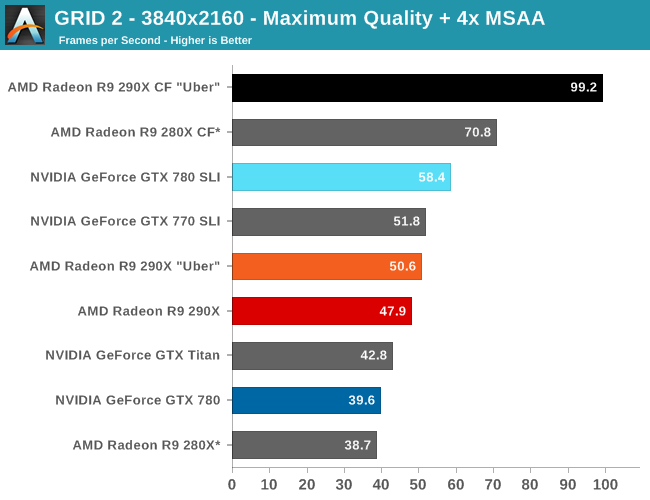
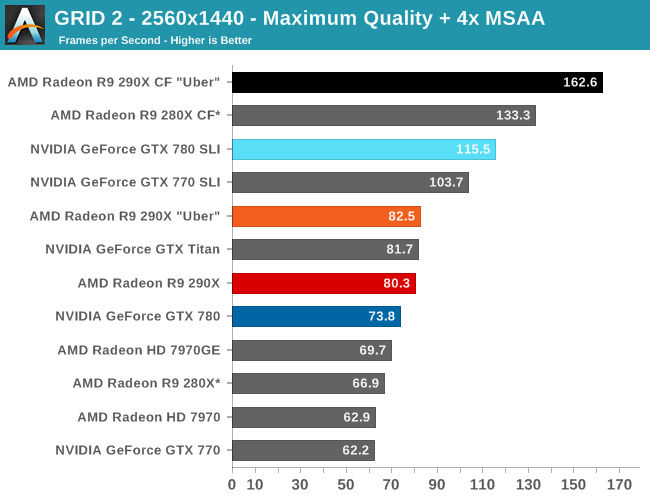
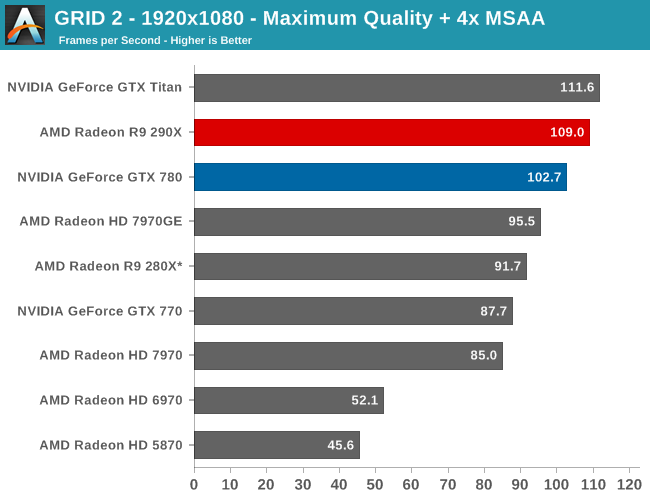
For as good looking as GRID 2 is, it continues to surprise us just how easy it is to run with everything cranked up, even the DirectCompute lighting system and MSAA (Forward Rendering for the win!). At 2560 the 290X has the performance advantage by 9%, but we are getting somewhat academic since it’s 80fps versus 74fps, placing both well above 60fps. Though 120Hz gamers may still find the gap of interest.
Moving up to 4K, we can still keep everything turned up including the MSAA, while pulling off respectable single-GPU framerates and great multi-GPU framerates. To no surprise at this point, the 290X further extends its lead at 4K to 21%, but as usually is the case you really want two GPUs here to get the best framerates. In which case the 290X CF is the runaway winner, achieving a scaling factor of 96% at 4K versus NVIDIA’s 47%, and 97% versus 57% at 2560. This means the GTX 780 SLI is going to fall just short of 60fps once more at 4K, leaving the 290X CF alone at 99fps.
Unfortunately for AMD their drivers coupled with GRID 2 currently blows a gasket when trying to use 4K @ 60Hz, as GRID 2 immediately crashes when trying to load with 4K/Eyefinity enabled. We can still test at 30Hz, but those stellar 4K framerates aren’t going to be usable for gaming until AMD and Codemasters get that bug sorted out.
Finally, it’s interesting to note that for the 290X this is the game where it gains the least on the 280X. The 290X performance advantage here is just 20%, 5% lower than any other game and 10% lower than the average. The framerates at 2560 are high enough that this isn’t quite as important as in other games, but it does show that the 290X isn’t always going to maintain that 30% lead over its predecessor.
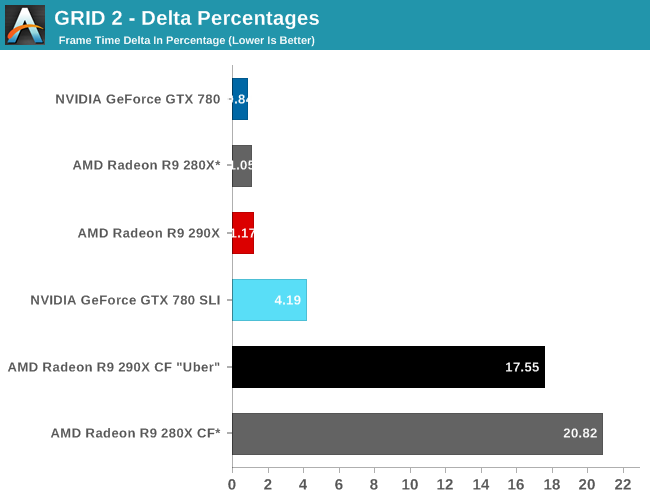
Without any capturable 4K FCAT frametimes, we’re left with the delta percentages at 2560, which more so than any other game are simply not in AMD’s favor. The GTX 780 SLI is extremely consistent here, to the point of being almost absurdly so for a multi-GPU setup. 4% is the kind of variance we expect to find with a single-GPU setup, not something incorporating multiple GPUs. AMD on the other hand, though improving over the 280X by a few percent, is merely adequate at 17%. The low frame times will further reduce the real world impact of the difference between the GTX 780 SLI and 290X CF here, but this is another game AMD could stand some improvements, even if it costs AMD some of the 290X’s very strong CF scaling factor.


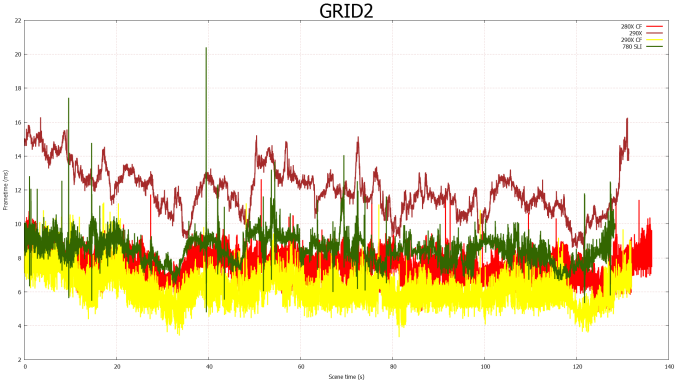








396 Comments
View All Comments
OverclockedCeleron - Thursday, October 24, 2013 - link
That made my day!pattycake0147 - Friday, October 25, 2013 - link
Yes! Comment of the day.TheinsanegamerN - Friday, October 25, 2013 - link
[reply in progress]OverclockedCeleron - Thursday, October 24, 2013 - link
Well done AMD, keep up the good work! Now it's the CPU turn ;).aTaoZ - Thursday, October 24, 2013 - link
Over in the overclocker uk forum, Gibbo is hinting the performance of non-x version in his 290X overclocking review. It is highly possible R9 290 will match GTX780 in performance at an even lower price.steelmilkjug - Friday, October 25, 2013 - link
It's good to see NVidia and AMD jockeying for the high end. Competition always helps keep prices realistic. Everytime I buy GPUs I go through the same mental struggle: Nvidia with better power/temp efficiency (roughly stated I know), AMD with slightly better price/performance ratios, sometimes significantly better. In the end, it always comes down to one thing for me: drivers. NVidia just seems to be more proactive in supporting their products, new drivers seem to come more often, and I feel the affect in games , usually. Less dual card issues, generally and a seemingly broader support of games in general. NVidia is a graphics hardware company specifically. AMD is not. They are a computer hardware company with a graphics department. And it shows. I'm an electrical engineer and I've seen how hard it is to get a job as an NVidia EE. It's a world renowned job, and they only pick the best in the world. I'm not sure AMD is quite as stringent.manicmonday - Friday, October 25, 2013 - link
So you think second tier engineers at AMD created a chip 25% smaller with better performance?SunLord - Friday, October 25, 2013 - link
Did Ryan quit or pass away 1/3 of the way through writing this review other this is pathetic so much for being a top tier review site.piroroadkill - Friday, October 25, 2013 - link
Yep. I gave them a while, some pages have now populated, but there are still too many empty ones. This is pretty poor.These days it seems like Apple gets all the coverage. Well, I couldn't really give a rats ass about massively long Apple articles. After all, Apple just wrap things up (such as GCN, Intel CPUs) into shiny boxes.
I think most of your readership is probably interested in the underlying tech, too.
Da W - Friday, October 25, 2013 - link
Man what do you do for a living? Quit bitching about other people's work, if you're not happy go somewhere else and STFU.